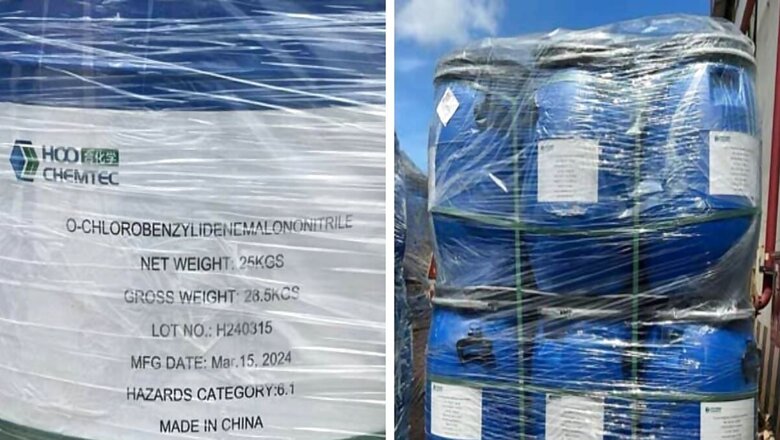
views
The Karachi-bound ship ‘Hyundai Shanghai’ (sailing under the Cyprus flag) set sail from Shanghai Port, China on 18 April 2024, and reached Adani Kattupalli Port Private Limited, in Tamil Nadu, Chennai, on 8 May 2024. Little did anyone realise that the Kattupalli port, classified as a minor port by the Tamil Nadu Maritime Board, would become the cynosure of global intelligence agencies, sending everyone into a tizzy.
Customs officers intercepted a consignment of 103 drums of 25 kg each, totalling 2,560 kilograms, of a chemical known as Ortho-Chloro Benzylidene Malononitrile or CS. The 2,560-kg shipment originated from the Chinese firm Chengdu Shichen Trading Co. Ltd. and was consigned to Rohail Enterprises, a Rawalpindi-based defence supplier in Pakistan.
Ortho-Chloro Benzylidene Malononitrile, or CS, while it has civilian applications as a riot control agent, the massive quantity seized raises concerns about its potential military application and likelihood for use in Balochistan and Kashmir. As it could be used for chemical and biological warfare programmes, the Customs authorities detained the consignment under India’s Export Control List of Special Chemicals, Organisms, Materials, Equipment and Technologies (SCOMET) as a controlled substance. Additionally, it was a listed substance under the Wassenaar Arrangement, of which India is a signatory. The shipment was seized under the provisions of the Customs Act, 1962, and the Weapons of Mass Destruction and their Delivery Systems (Prohibition of Unlawful Activities) Act, 2005.
Interestingly, neither Pakistan nor China is a signatory to the Wassenaar Arrangement, a voluntary export control regime established in July 1996 with 42 member countries. Members share information on dual-use goods and technologies, as well as controlled substances.
Ortho-Chloro Benzylidene Malononitrile is a major riot control agent (RCA) currently used by US military forces. First synthesised in 1928 by Corson and Stoughton, the compound was designated “CS” by the US Army after the scientists’ initials. Classified as a non-lethal or less-than-lethal chemical, CS is used in riot control situations to disperse crowds, clear facilities, and deny access to areas. Its effects include distraction, deterrence, disorientation, and incapacitation. Released as fine droplets or particles, CS can be absorbed through skin contact, eye contact, or inhalation.
The seizure of the consignment also comes amid reports of China regularly supplying other “dual-use” items to Pakistan. It also underscores the complicity of China in aiding Pakistan’s military programs, especially those related to CBRN (Chemicals, Biological, Radiological and Nuclear).
India was inducted into the Wassenaar Arrangement on December 7, 2017, as its 42nd member. The Wassenaar Arrangement (WA) is widely recognised as one of four major Multilateral Export Control Regimes (MECR) that help address international security and stability by strengthening international non-proliferation efforts. It aims to prevent the undesired transfer of conventional arms, dual-use items, and technologies to nefarious actors. India’s membership signifies its recognition as a nation possessing dual-use technology capabilities, which will further support its defence and space sectors. The WA membership is expected to build up a strong case for India’s entry into the Nuclear Suppliers Group (NSG).
Within its Munitions List 7 (ML7), the Wassenaar Arrangement includes chemical agents, biological agents, riot control agents, radioactive materials, related equipment, components, and materials. While CS gas is categorised as a riot control agent, it can be lethal in large quantities. Its use in warfare is prohibited under the Chemical Weapons Convention (CWC), which came into effect in 1997. Though many countries signed the CWC in 1993, an exception allows the use of CS gas for domestic riot control. Participating States aim, through their national policies, to ensure that transfers of arms and dual-use goods and technologies do not contribute to the development or enhancement of military capabilities that undermine international and regional security and stability, nor are they diverted to support such capabilities.
China has been stonewalling India’s application to the NSG, which regulates international nuclear commerce, on the grounds that India is not a signatory to the Non-Proliferation Treaty (NPT). China is currently a significant source country for many types of conventional weapons and dual-use items, hence, understanding China’s non-membership of the WA is crucial to determine its covert trade activities. Significantly, as China’s own industrial and economic development progressed, it saw fewer benefits in WA membership, realising that exporting high-tech products to non-WA countries was more profitable.
As an economic powerhouse and major international power, China is a primary manufacturer, supplier, and developer of a large number of advanced conventional weapons, dual-use items and related technologies. In the 2000s, Washington established the so-called ‘China Rule’, which, as its name suggests, specifically targets China. The US specifically modified the export control rules to target sensitive exports to China, reflecting increasing concerns regarding China’s acquisition of high-tech goods.
The China Rule includes two parts: First, it imposed tighter controls on a limited number of technologies if they are knowingly intended for military end-use in China (the Military End-Use List), and second, it established a mechanism aimed at facilitating trade with trusted civilian end-users in China (the Validated End-User program, VEU). China’s exports to countries of concern can be viewed as a result of this disconnect. Its behaviour of exporting sensitive items to countries, pursuing clandestine CBRN programs, and its relatively weak export control regime characterise China as a country of concern.
On July 11, 2024, the first Chinese containership reached the new Vizhinjam port in Kerala, near Trivandrum. The vessel “San Fernando” set sail from Xiamen port in China. India needs to be very vigilant and keep a close watch not only on what is entering our country but also on what is transiting through the country’s many seaports and airports.
The writer is a retired officer of the IRS and the former director-general of the National Academy of Customs, Indirect Taxes & Narcotics. Views expressed in the above piece are personal and solely that of the author. They do not necessarily reflect News18’s views.


















Comments
0 comment